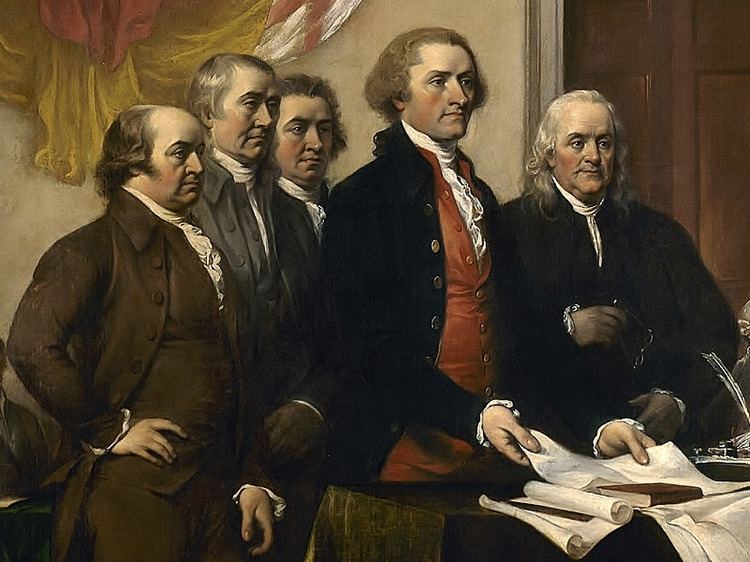 | ||
The Committee of Five of the Second Continental Congress were a team of five men who drafted and presented to the Congress what would become America's Declaration of Independence of July 4, 1776. This Declaration committee operated from June 11, 1776 until July 5, 1776, the day on which the Declaration was published.
Contents
The Committee
The members of this group were:
Drafting of the Declaration of Independence
The delegates of the United Colonies in Congress resolved to postpone until Monday, July 1, the final consideration of whether or not to declare the several sovereign independencies of the United Colonies, which had been proposed by the North Carolina resolutions of April 12 and the Virginia resolutions of May 15. The proposal was moved in Congress on June 7 by Richard Henry Lee of Virginia; known as the Lee Resolution. During these allotted three weeks Congress agreed to appoint a committee to draft a broadside statement to proclaim to the world the reasons for taking America out of the British Empire, if the Congress were to declare the said sovereign independencies. The actual declaration of "American Independence" is precisely the text comprising the final paragraph of the published broadside of July 4. The broadside's final paragraph repeated the text of the Lee Resolution as adopted by the declaratory resolve voted on July 2.
On June 11, the Committee of Five was appointed: John Adams of Massachusetts, Roger Sherman of Connecticut, Robert Livingston of New York, Benjamin Franklin of Pennsylvania, and Thomas Jefferson of Virginia. Because the committee left no minutes, there is some uncertainty about how the drafting process proceeded—accounts written many years later by Jefferson and Adams, although frequently cited, are contradictory and not entirely reliable.
The First Draft
Certainly the committee, after discussing the general outline that the document should follow, decided that Jefferson would write the first draft. With Congress's busy schedule, Jefferson had limited time to write the draft over the ensuing 17 days. He then consulted with the others on the committee, who reviewed the draft and made extensive changes. Jefferson then produced another copy incorporating these alterations.
Among the changes was the simplification of the phrase Life, Liberty and the pursuit of Happiness, which Jefferson had phrased "preservation of life, & liberty, & the pursuit of happiness". This was a return to wording closer to John Locke's original description of private property as a natural right, in the phrase "life, liberty, and estate".
Presentation of the Draft
On June 28, 1776, the committee presented this copy to the "Committee of the Whole" Congress, which was commemorated by one of the most famous paintings in US history (shown). The title of the document was "A Declaration by the Representatives of the United States of America, in General Congress assembled."
The Signing
Although not officially noted, the estimated time was 18:26 LMT (6:26pm local) for the recording of this historic vote. The Congress then heard the report of the Committee of the Whole and declared the sovereign status of the United Colonies the following day, during the afternoon of July 2. The Committee of the Whole then turned to the Declaration, and it was given a second reading before adjournment.
Last minute arguments
On Wednesday, July 3, the Committee of the Whole gave the Declaration a third reading and commenced scrutiny of the precise wording of the proposed text. Two passages in the Committee of Five's draft were rejected by the Committee of the Whole. One was a critical reference to the English people and the other was a denunciation of the slave trade and of slavery itself. The text of the Declaration was otherwise accepted without any other major changes.
Jefferson wrote in his autobiography, of the two deleted passages:
As John Adams recalled many years later, this work of editing the proposed text was largely completed by the time of adjournment on July 3. However, the text's formal adoption was deferred until the following morning, when the Congress voted its agreement during the late morning of July 4.
Fair Copy
The draft document as adopted was then referred back to the Committee of Five in order to prepare a "fair copy," this being the redrafted-as-corrected document prepared for delivery to the broadside printer, John Dunlap. And so the Committee of Five convened in the early evening of July 4 to complete its task.
Historians have had no documentary means by which to determine the identity of the authenticating party. It is unclear whether the Declaration was authenticated by the Committee of Five's signature or the Committee submitted the fair copy to President Hancock for his authenticating signature, or the authentication awaited President John Hancock’s signature on the printer’s finished proof-copy of what became known as the Dunlap broadside Either way, upon the July 5 release of the Dunlap broadside of the Declaration, the Committee of Five’s work was done.
The Dunlap broadside release to the public
Upon the July 5 release of the Dunlap broadside, the public could read who had signed the Declaration. Just one signature as attested by Secretary Charles Thomson. Memories of the participants proved to be very short on this particular historic moment. Not three decades had elapsed by which time the prominent members of the Committee of Five could no longer recollect in detail what actually took place, and by their active participation, on July 4 and 5 of 1776. And so during these early decades was born the myth of a one grand ceremonial general signing on July 4, by all the delegates to Congress. The myth continues to have a very long life.
